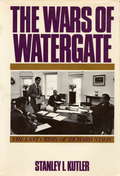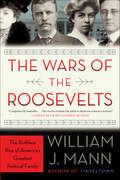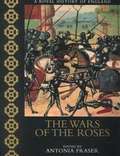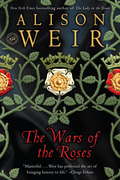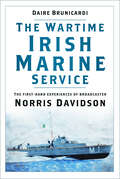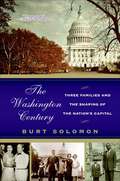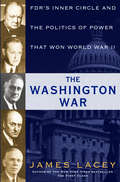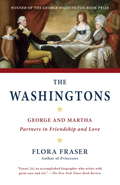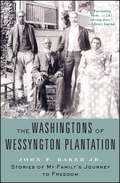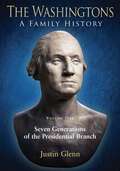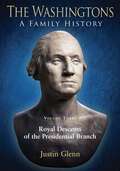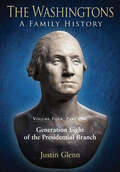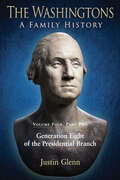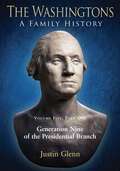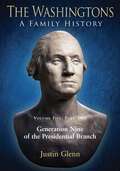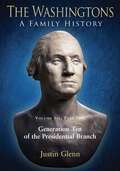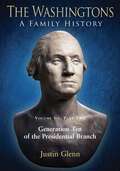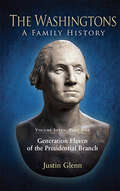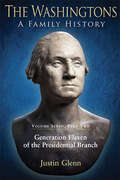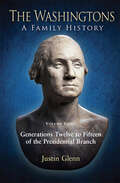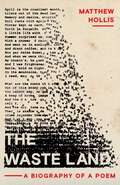- Table View
- List View
The Wars of Watergate
by Stanley I. KutlerThis is the first truly comprehensive history of the political explosion that shook America in the 1970s, and whose aftereffects are still being felt in public life today. Drawing on contemporary documents, personal interviews, memoirs, and a vast quantity of new material, Stanley Kutler shows how President Nixon's obstruction of justice from the White House capped a pattern of abuse that marked his entire tenure in office. He makes clear how the drama of Watergate is rooted not only in the tumultuous events and social tensions of the 1960s but also in the personality and history of Richard Nixon. Kutler examines Nixon's confrontations with the institutions he feared and resented--the Congress, the federal agencies, the news media, the Washington establishment--and how they mobilized to topple the President. He considers the arguments of Nixon's defenders, who insisted that Watergate was a minor affair, and the contention that the President did nothing worse than his predecessors had done. He offers compelling portraits of the President's men--H. R. Haldeman, John Ehrlichman, John Mitchell, Charles Colson, John Dean; of his adversaries--Judge John Sirica, the U.S. Attorneys, Special Prosecutors Archibald Cox and Leon Jaworski; and of the legislators who would stand in judgment--Sam Ervin and Peter Rodino. In the course of his engrossing narrative, Stanley Kutler illuminates the constitutional crisis brought on by Watergate. He shows how Watergate diminished the moral level of American political life, and illustrates its continuing detrimental impact on the credibility, authority, and prestige of the Presidency in particular and the government in general. His book underlines for the American electorate the significance of Watergate for the future of our political ethics and the maintenance of our constitutional system, as well as for the place of Richard Nixon in American history.
The Wars of the Roosevelts: The Ruthless Rise of America's Greatest Political Family
by William J. MannThe award-winning author presents a provocative, thoroughly modern revisionist biographical history of one of America’s greatest and most influential families—the Roosevelts—exposing heretofore unknown family secrets and detailing complex family rivalries with his signature cinematic flair.Drawing on previously hidden historical documents and interviews with the long-silent "illegitimate" branch of the family, William J. Mann paints an elegant, meticulously researched, and groundbreaking group portrait of this legendary family. Mann argues that the Roosevelts’ rise to power and prestige was actually driven by a series of intense personal contest that at times devolved into blood sport. His compelling and eye-opening masterwork is the story of a family at war with itself, of social Darwinism at its most ruthless—in which the strong devoured the weak and repudiated the inconvenient. Mann focuses on Eleanor Roosevelt, who, he argues, experienced this brutality firsthand, witnessing her Uncle Theodore cruelly destroy her father, Elliott—his brother and bitter rival—for political expediency. Mann presents a fascinating alternate picture of Eleanor, contending that this "worshipful niece" in fact bore a grudge against TR for the rest of her life, and dares to tell the truth about her intimate relationships without obfuscations, explanations, or labels.Mann also brings into focus Eleanor’s cousins, TR’s children, whose stories propelled the family rivalry but have never before been fully chronicled, as well as her illegitimate half-brother, Elliott Roosevelt Mann, who inherited his family’s ambition and skill without their name and privilege. Growing up in poverty just miles from his wealthy relatives, Elliott Mann embodied the American Dream, rising to middle-class prosperity and enjoying one of the very few happy, long-term marriages in the Roosevelt saga. For the first time, The Wars of the Roosevelts also includes the stories of Elliott’s daughter and grandchildren, and never-before-seen photographs from their archives.Deeply psychological and finely rendered, illustrated with sixteen pages of black-and-white photographs, The Wars of the Roosevelts illuminates not only the enviable strengths but also the profound shame of this remarkable and influential family.
The Wars of the Roses
by Antonia Fraser Anthony CheethamEach of these lavishly illustrated books serves up a brief and manageable portion of the Fraser-edited and much-touted Lives of the Kings and Queens of England. A set of six jewels for Fraser's crown.
The Wars of the Roses: The Fall of the Plantagenets and the Rise of the Tudors
by Dan JonesThe author of the New York Times bestseller The Plantagenets chronicles the next chapter in British history--the historical backdrop for Game of ThronesThe crown of England changed hands five times over the course of the fifteenth century, as two branches of the Plantagenet dynasty fought to the death for the right to rule. In this riveting follow-up to The Plantagenets, celebrated historian Dan Jones describes how the longest-reigning British royal family tore itself apart until it was finally replaced by the Tudors.Some of the greatest heroes and villains of history were thrown together in these turbulent times, from Joan of Arc to Henry V, whose victory at Agincourt marked the high point of the medieval monarchy, and Richard III, who murdered his own nephews in a desperate bid to secure his stolen crown. This was a period when headstrong queens and consorts seized power and bent men to their will. With vivid descriptions of the battles of Towton and Bosworth, where the last Plantagenet king was slain, this dramatic narrative history revels in bedlam and intrigue. It also offers a long-overdue corrective to Tudor propaganda, dismantling their self-serving account of what they called the Wars of the Roses.
The Wars of the Roses: The Wars Of The Roses
by Alison WeirLancaster and York. For much of the fifteenth century, these two families were locked in battle for control of the British monarchy. Kings were murdered and deposed. Armies marched on London. Old noble names were ruined while rising dynasties seized power and lands. The war between the royal House of Lancaster and York, the longest and most complex in British history, profoundly altered the course of the monarchy. In The Wars of the Roses, Alison Weir reconstructs this conflict with the same dramatic flair and impeccable research that she brought to her highly praised The Princes in the Tower.The first battle erupted in 1455, but the roots of the conflict reached back to the dawn of the fifteenth century, when the corrupt, hedonistic Richard II was sadistically murdered, and Henry IV, the first Lancastrian king, seized England's throne. Both Henry IV and his son, the cold warrior Henry V, ruled England ably, if not always wisely--but Henry VI proved a disaster, both for his dynasty and his kingdom. Only nine months old when his father's sudden death made him king, Henry VI became a tormented and pathetic figure, weak, sexually inept, and prey to fits of insanity. The factional fighting that plagued his reign escalated into bloody war when Richard Plantagenet, Duke of York, laid claim to the throne that was rightfully his--and backed up his claim with armed might.Alison Weir brings brilliantly to life both the war itself and the historic figures who fought it on the great stage of England. Here are the queens who changed history through their actions--the chic, unconventional Katherine of Valois, Henry V's queen; the ruthless, social-climbing Elizabeth Wydville; and, most crucially, Margaret of Anjou, a far tougher and more powerful character than her husband,, Henry VI, and a central figure in the Wars of the Roses.Here, too, are the nobles who carried the conflict down through the generations--the Beauforts, the bastard descendants of John of Gaunt, Richard Neville, Earl of Warwick, known to his contemporaries as "the Kingmaker"; and the Yorkist King, Edward IV, a ruthless charmer who pledged his life to cause the downfall of the House of Lancaster.The Wars of the Roses is history at its very best--swift and compelling, rich in character, pageantry, and drama, and vivid in its re-creation of an astonishing, dangerous, and often grim period of history. Alison Weir, one of the foremost authorities on the British royal family, demonstrates here that she is also one of the most dazzling stylists writing history today.
The Wartime Irish Marine Service: The first-hand experiences of broadcaster Norris Davidson
by Daire Brunicardi‘It was a farewell to all my pleasant life, a farewell to the enjoyment of summer. My theme was that we were all about to undergo a change. The hills and the streams would remain, the sun would set as redly on the western sea, but they would not ever be quite the same for us again.’In the 1930s, Norris Davidson was based in London, where he was involved in pioneering work on film, radio and documentaries. By the start of the 1940s, he was working in the wartime Marine Service. Davidson’s informative account of his experience in the Irish Marine Service during the Second World War gives a refreshing insight into many aspects of the defence forces preparing to defend the state to the best of its ability. Often humorous and sometimes moving, it is an engaging account that will appeal to all who are interested in Irish maritime and military history, as well as day-to-day life in 1940s Ireland.Before his death, Norris entrusted the manuscript to ex-naval officer Daire Brunicardi, who has added to the manuscript with a foreword to set the scene, as well as providing some fascinating photos and wartime ephemera.
The Washington Century: Three Families and the Shaping of the Nation's Capital
by Burt SolomonThe Washington Century chronicles the hundred-year rise of the nation's capital as it grew to become the most powerful city in the world -- a story made vivid through the history of three very different families, each representing an essential aspect of Washington: the Cafritzes, headed by a real estate mogul and his consummate hostess wife; the Boggs family, a political force in the ultimate political town; and the Hobsons, lead by a prominent black activist and civic leader in the first black-majority American city. Veteran journalist Burt Solomon uses these families to explore everything from the customs of Washington's elite society to the expansion of the federal bureaucracy, the District's own struggle for self-governance, and the influential role that politics and, increasingly, lobbying have played in the city.
The Washington War: FDR's Inner Circle and the Politics of Power That Won World War II
by James LaceyA Team of Rivals for World War II—the inside story of how FDR and the towering personalities around him waged war in the corridors of Washington, D.C., to secure ultimate victory on the battlefields of Europe and the Pacific. The Washington War is the story of how the Second World War was fought and won in the capital’s halls of power—and how the United States, which in December 1941 had a nominal army and a decimated naval fleet, was able in only thirty months to fling huge forces onto the European continent and shortly thereafter shatter Imperial Japan’s Pacific strongholds. Three quarters of a century after the overwhelming defeat of the totalitarian Axis forces, the terrifying, razor-thin calculus on which so many critical decisions turned has been forgotten—but had any of these debates gone the other way, the outcome of the war could have been far different: The army in August 1941, about to be disbanded, saved by a single vote. Production plans that would have delayed adequate war matériel for years after Pearl Harbor, circumvented by one uncompromising man’s courage and drive. The delicate ballet that precluded a separate peace between Stalin and Hitler. The almost-adopted strategy to stage D-Day at a fatally different time and place. It was all a breathtakingly close-run thing, again and again. Renowned historian James Lacey takes readers behind the scenes in the cabinet rooms, the Pentagon, the Oval Office, and Hyde Park, and at the pivotal conferences—Campobello Island, Casablanca, Tehran—as these disputes raged. Here are colorful portraits of the great figures—and forgotten geniuses—of the day: New Dealers versus industrialists, political power brokers versus the generals, Churchill and the British high command versus the U.S. chiefs of staff, innovators versus entrenched bureaucrats . . . with the master manipulator, Franklin Delano Roosevelt, at the center, setting his brawling patriots one against the other and promoting and capitalizing on the furious turf wars. Based on years of research and extensive, previously untapped archival resources, The Washington War is the first integrated, comprehensive chronicle of how all these elements—and towering personalities—clashed and ultimately coalesced at each vital turning point, the definitive account of Washington at real war and the titanic political and bureaucratic infighting that miraculously led to final victory.
The Washingtons
by Flora FraserA full-scale portrait of the marriage of the father and mother of our country--and of the struggle for independence that he led The Washingtons' long union begins in colonial Virginia in 1759, when George Washington woos and weds Martha Dandridge Parke Custis, a pretty, charming, and very rich young widow. The calm early years of their marriage as plantation owners at Mount Vernon and as parents to Martha's two children, Jacky and Patsy--both of whom present difficult challenges--yield to harsher times. Washington has been prominent among Virginians in opposing British government measures, and at the outbreak of fighting in 1775 he is elected commander-in-chief of the Continental army. The war sees Martha resolutely supporting her husband, sharing in the hardships at Valley Forge and other wretched winter headquarters. Essential to George's personal well-being, she is known as "Lady Washington"--a redoubtable and vastly admired figure in her own right.Flora Fraser provides us with a brilliant account of the public Washington and of the war he waged, and gives us, as well, the domestic Washingtons, whether at Mount Vernon before and during the war or in New York and Philadelphia during his presidency. Even in wartime, Martha manages to scour Philadelphia to find a doll for her newest granddaughter and keeps careful control of her Virginia inheritance. George grapples with a formidable enemy, without proper troops and often without basic supplies--his soldiers frequently lack rations, blankets, even shoes--while always fearful for his wife's welfare and safety, given the constant worry that the British might descend on Mount Vernon. Even so, a true Virginian, he manages to dance for more than three hours with Alexander Hamilton's pretty young wife at a makeshift ball.With victory and the arrival of peace in 1783, the Washingtons hope to remain at home, a hope dashed when, in 1789, George is elected our first president and Martha becomes a faultless first First Lady. During the presidency, they together negotiate the many pitfalls of establishing republican entertainment--the weekly "Congress dinner," levées, and drawing rooms--before, finally free of official responsibilities after Washington's second term, they are at last able to retreat to their beloved Mount Vernon.This is a remarkable story of a remarkable pair as well as a gripping narrative of the birth of a nation--a major, and vastly appealing, contribution to the literature of our founding fathers . . . and founding mother.From the Hardcover edition.
The Washingtons of Wessyngton Plantation: Stories of My Family's Journey to Freedom
by John BakerWhen John F. Baker Jr. was in the seventh grade, he saw a photograph of four former slaves in his social studies textbook—two of them were his grandmother's grandparents. He began the lifelong research project that would become The Washingtons of Wessyngton Plantation, the fruit of more than thirty years of archival and field research and DNA testing spanning 250 years.A descendant of Wessyngton slaves, Baker has written the most accessible and exciting work of African American history since Roots. He has not only written his own family's story but included the history of hundreds of slaves and their descendants now numbering in the thousands throughout the United States. More than one hundred rare photographs and portraits of African Americans who were slaves on the plantation bring this compelling American history to life. Founded in 1796 by Joseph Washington, a distant cousin of America's first president, Wessyngton Plantation covered 15,000 acres and held 274 slaves, whose labor made it the largest tobacco plantation in America. Atypically, the Washingtons sold only two slaves, so the slave families remained intact for generations. Many of their descendants still reside in the area surrounding the plantation. The Washington family owned the plantation until 1983; their family papers, housed at the Tennessee State Library and Archives, include birth registers from 1795 to 1860, letters, diaries, and more. Baker also conducted dozens of interviews—three of his subjects were more than one hundred years old—and discovered caches of historic photographs and paintings. A groundbreaking work of history and a deeply personal journey of discovery, The Washingtons of Wessyngton Plantation is an uplifting story of survival and family that gives fresh insight into the institution of slavery and its ongoing legacy today.
The Washingtons. Volume 1: Seven Generations of the Presidential Branch (The Washingtons: A Family History #1)
by Justin GlennThis is the initial volume of a comprehensive history that traces the “Presidential line” of the Washingtons. Volume one begins with the immigrant John Washington who settled in Westmoreland Co., Va., in 1657, married Anne Pope, and was the great-grandfather of President George Washington. This volume continues the story of John and Anne’s family for a total of seven generations, collecting over 5,000 direct descendants. Future volumes will trace eight more generations with a total of over 63,000 descendants. Although structured in a genealogical format for the sake of clarity, this is no bare bones genealogy but a true family history with over 1,200 detailed biographical narratives. These in turn strive to convey the greatness of the family that produced not only The Father of His Country but many others, great and humble, who struggled to build that country. The Washingtons includes the time-honored John Wright line which in recent years has been challenged largely on the basis of DNA evidence. Volumes one and two will form a set, with a cumulative bibliography appearing at the end of volume 2. Volume two will highlight the most notable descendants and spouses from the later volumes, including such luminaries as General George S. Patton, the author Shelby Foote, and the actor Lee Marvin. All of the volumes, now estimated at fourteen in all, are virtually complete and are scheduled for release over the course of the next year.
The Washingtons. Volume 2: Notable Members of the Presidential Branch (The Washingtons: A Family History #2)
by Justin GlennThis is the second volume of a comprehensive history that traces the “Presidential line” of the Washingtons. Volume one began with the immigrant John Washington who settled in Westmoreland Co., Va., in 1657, married Anne Pope, and was the great-grandfather of President George Washington. It continued the record of their descendants for a total of seven generations. Volume two is a collection of notable descendants of the next eight generations of John and Anne Washington’s descendants, including such luminaries as General George S. Patton, the author Shelby Foote, and the actor Lee Marvin. Future volumes will trace generations eight through fifteen, making a total of over 63,000 descendants. Although structured in a genealogical format for the sake of clarity, this is no bare bones genealogy but a true family history with over 1,200 detailed biographical narratives. These in turn strive to convey the greatness of the family that produced not only The Father of His Country but many others, great and humble, who struggled to build that country. The Washingtons includes the time-honored John Wright line which in recent years has been challenged largely on the basis of DNA evidence. Volumes one and two form a set, with a cumulative bibliography appearing at the end of volume two.
The Washingtons. Volume 3: Royal Descents of the Presidential Branch (The Washingtons: A Family History #3)
by Justin GlennThis Royal Descents supplement is an outgrowth of the author’s multi-volume family history of the “Presidential Branch” of the Washingtons. That work collects the descendants of the immigrant John Washington who settled in Westmoreland Co., Va., in 1657, married Anne Pope, and became the great-grandfather of President George Washington. The Royal Descents traces the ancestry of the early Virginia members of this “Presidential Branch” back in time to the aristocracy and nobility of England and continental Europe, including the Plantagenet dynasty, William the Conqueror, Alfred the Great, Charles Martel, and Charlemagne. ADVANCE PRAISE for The Washingtons: A Family History “I am convinced that your work will be of wide interest to historians and academics as well as members of the Washington family itself. Although the surname Washington is perhaps the best known in American history and much has been written about the Washington family for well over a century, it is surprising that no comprehensive family history has been published. Justin M. Glenn’s The Washingtons: A Family History finally fills this void for the branch to which General and President George Washington belonged, identifying some 63,000 descendants. This is truly a family history, not a mere tabulation of names and dates, providing biographical accounts of many of the descendants of John Washington who settled in Westmoreland County, Virginia, in 1657. . . . Each individual section is followed by extensive listings of published and manuscript sources supporting the information presented and errors of identification in previous publications are commented upon as appropriate.” John Frederick Dorman, editor of The Virginia Genealogist (1957-2006) and author of Adventurers of Purse and Person “Decades of reviewing Civil War books have left me surprised and delighted when someone applies exhaustive diligence to a topic not readily accessible. Dr. Glenn surely meets that standard with the meticulous research that unveils the Washington family in gratifying detail—many of them Confederates of interest and importance.” Robert K. Krick, author of The Smoothbore Volley that Doomed the Confederacy and Stonewall Jackson at Cedar Mountain
The Washingtons. Volume 4, Part 1: Generation Eight of the Presidential Branch (The Washingtons: A Family History #4.2)
by Justin GlennThis is the fourth volume of Dr. Justin Glenn’s comprehensive history that traces the “Presidential line” of the Washingtons. Volume One began with the immigrant John Washington, who settled in Westmoreland Co., Va., in 1657, married Anne Pope, and became the great-grandfather of President George Washington. It continued the record of their descendants for a total of seven generations. Volume Two highlighted notable members of the next eight generations of John and Anne Washington’s descendants, including General George S. Patton, author Shelby Foote, and actor Lee Marvin. Volume Three traced the ancestry of the early Virginia members of this “Presidential Branch” back in time to the aristocracy and nobility of England and continental Europe. Volume Four resumes the family history where Volume One ended. It presents Generation Eight of the immigrant John Washington’s descendants, containing nearly 7,000 descendants. Future volumes will trace generations nine through fifteen, making a total of over 63,000 descendants. Although structured in a genealogical format for the sake of clarity, this is no bare bones genealogy but a true family history with over 1,200 detailed biographical narratives. These in turn strive to convey the greatness of the family that produced not only The Father of His Country but many others, great and humble, who struggled to build that country. Volume Four, Part One covers the descendants of the immigrant John Washington’s child Lawrence Washington. Volume Four, Part Two covers the descendants of the Immigrant’s children John Washington, Jr., and Anne (Washington) Wright.
The Washingtons. Volume 4, Part 2: Generation Eight of the Presidential Branch (The Washingtons: A Family History #4.2)
by Justin GlennThis is the fourth volume of Dr. Justin Glenn’s comprehensive history that traces the “Presidential line” of the Washingtons. Volume One began with the immigrant John Washington, who settled in Westmoreland Co., Va., in 1657, married Anne Pope, and became the great-grandfather of President George Washington. It continued the record of their descendants for a total of seven generations. Volume Two highlighted notable members of the next eight generations of John and Anne Washington’s descendants, including General George S. Patton, author Shelby Foote, and actor Lee Marvin. Volume Three traced the ancestry of the early Virginia members of this “Presidential Branch” back in time to the aristocracy and nobility of England and continental Europe. Volume Four resumes the family history where Volume One ended. It presents Generation Eight of the immigrant John Washington’s descendants, containing nearly 7,000 descendants. Future volumes will trace generations nine through fifteen, making a total of over 63,000 descendants. Although structured in a genealogical format for the sake of clarity, this is no bare bones genealogy but a true family history with over 1,200 detailed biographical narratives. These in turn strive to convey the greatness of the family that produced not only The Father of His Country but many others, great and humble, who struggled to build that country. Volume Four, Part One covers the descendants of the immigrant John Washington’s child Lawrence Washington. Volume Four, Part Two covers the descendants of the Immigrant’s children John Washington, Jr., and Anne (Washington) Wright.
The Washingtons. Volume 5, Part 1: Generation Nine of the Presidential Branch (The Washingtons: A Family History #5.1)
by Justin GlennThis is the fifth volume of Dr. Justin Glenn’s comprehensive history that traces the “Presidential line” of the Washingtons. Volume One began with the immigrant John Washington, who settled in Westmoreland Co., Va., in 1657, married Anne Pope, and became the great-grandfather of President George Washington. It continued the record of their descendants for a total of seven generations. Volume Two highlighted notable family members in the next eight generations of John and Anne Washington’s descendants, including such luminaries as General George S. Patton, the author Shelby Foote, and the actor Lee Marvin. Volume Three traced the ancestry of the early Virginia members of this “Presidential Branch” back in time to the aristocracy and nobility of England and continental Europe. Volume Four resumed the family history where Volume One ended, and it contained Generation Eight of the immigrant John Washington’s descendants. Volume Five now presents Generation Nine, including more than 10,000 descendants. Future volumes will trace generations ten through fifteen, making a total of over 63,000 descendants. Although structured in a genealogical format for the sake of clarity, this is no bare bones genealogy but a true family history with over 1,200 detailed biographical narratives. These in turn strive to convey the greatness of the family that produced not only The Father of His Country but many others, great and humble, who struggled to build that country. ADVANCE PRAISE “I am convinced that your work will be of wide interest to historians and academics as well as members of the Washington family itself. Although the surname Washington is perhaps the best known in American history and much has been written about the Washington family for well over a century, it is surprising that no comprehensive family history has been published. Justin M. Glenn’s The Washingtons: A Family History finally fills this void for the branch to which General and President George Washington belonged, identifying some 63,000 descendants. This is truly a family history, not a mere tabulation of names and dates, providing biographical accounts of many of the descendants of John Washington who settled in Westmoreland County, Virginia, in 1657. . . . Each individual section is followed by extensive listings of published and manuscript sources supporting the information presented and errors of identification in previous publications are commented upon as appropriate.” John Frederick Dorman, editor of The Virginia Genealogist (1957-2006) and author of Adventurers of Purse and Person “Decades of reviewing Civil War books have left me surprised and delighted when someone applies exhaustive diligence to a topic not readily accessible. Dr. Glenn surely meets that standard with the meticulous research that unveils the Washington family in gratifying detail—many of them Confederates of interest and importance.” Robert K. Krick, author of The Smoothbore Volley that Doomed the Confederacy and Stonewall Jackson at Cedar Mountain
The Washingtons. Volume 5, Part 2: Generation Nine of the Presidential Branch (The Washingtons: A Family History #5.1)
by Justin GlennThis is the fifth volume of Dr. Justin Glenn’s comprehensive history that traces the “Presidential line” of the Washingtons. Volume One began with the immigrant John Washington, who settled in Westmoreland Co., Va., in 1657, married Anne Pope, and became the great-grandfather of President George Washington. It continued the record of their descendants for a total of seven generations. Volume Two highlighted notable family members in the next eight generations of John and Anne Washington’s descendants, including such luminaries as General George S. Patton, the author Shelby Foote, and the actor Lee Marvin. Volume Three traced the ancestry of the early Virginia members of this “Presidential Branch” back in time to the aristocracy and nobility of England and continental Europe. Volume Four resumed the family history where Volume One ended, and it contained Generation Eight of the immigrant John Washington’s descendants. Volume Five now presents Generation Nine, including more than 10,000 descendants. Future volumes will trace generations ten through fifteen, making a total of over 63,000 descendants. Although structured in a genealogical format for the sake of clarity, this is no bare bones genealogy but a true family history with over 1,200 detailed biographical narratives. These in turn strive to convey the greatness of the family that produced not only The Father of His Country but many others, great and humble, who struggled to build that country. ADVANCE PRAISE “I am convinced that your work will be of wide interest to historians and academics as well as members of the Washington family itself. Although the surname Washington is perhaps the best known in American history and much has been written about the Washington family for well over a century, it is surprising that no comprehensive family history has been published. Justin M. Glenn’s The Washingtons: A Family History finally fills this void for the branch to which General and President George Washington belonged, identifying some 63,000 descendants. This is truly a family history, not a mere tabulation of names and dates, providing biographical accounts of many of the descendants of John Washington who settled in Westmoreland County, Virginia, in 1657. . . . Each individual section is followed by extensive listings of published and manuscript sources supporting the information presented and errors of identification in previous publications are commented upon as appropriate.” John Frederick Dorman, editor of The Virginia Genealogist (1957-2006) and author of Adventurers of Purse and Person “Decades of reviewing Civil War books have left me surprised and delighted when someone applies exhaustive diligence to a topic not readily accessible. Dr. Glenn surely meets that standard with the meticulous research that unveils the Washington family in gratifying detail—many of them Confederates of interest and importance.” Robert K. Krick, author of The Smoothbore Volley that Doomed the Confederacy and Stonewall Jackson at Cedar Mountain
The Washingtons. Volume 6, Part 1: Generation Ten of the Presidential Branch (The Washingtons: A Family History #6.1)
by Justin GlennThis is the sixth volume of Dr. Justin Glenn’s comprehensive history that traces the “Presidential line” of the Washingtons. Volume One began with the immigrant John Washington, who settled in Westmoreland Co., Va., in 1657, married Anne Pope, and became the great-grandfather of President George Washington. It continued the record of their descendants for a total of seven generations. Volume Two highlighted notable family members in the next eight generations of John and Anne Washington’s descendants. Volume Three traced the ancestry of the early Virginia members of this “Presidential Branch” back to the aristocracy and nobility of England and continental Europe. Volume Four resumed the family history where Volume One ended, and it contained Generation Eight of the immigrant John Washington’s descendants. Volume Five treated Generation Nine. Volume Six now presents Generation Ten, and it includes over 12,000 descendants. Future volumes will add generations eleven through fifteen, making a total of over 63,000 descendants. Although structured in a genealogical format for the sake of clarity, this is no bare bones genealogy but a true family history with over 1,200 detailed biographical narratives. These in turn strive to convey the greatness of the family that produced not only The Father of His Country but many others, great and humble, who struggled to build that country. Volume Six, Part One covers the descendants of the Immigrant John Washington’s children Lawrence Washington and John Washington, Jr. Volume Six, Part Two covers the descendants of the Immigrant’s child Anne (Washington) Wright.
The Washingtons. Volume 6, Part 2: Generation Ten of the Presidential Branch (The Washingtons: A Family History #6.1)
by Justin GlennThis is the sixth volume of Dr. Justin Glenn’s comprehensive history that traces the “Presidential line” of the Washingtons. Volume One began with the immigrant John Washington, who settled in Westmoreland Co., Va., in 1657, married Anne Pope, and became the great-grandfather of President George Washington. It continued the record of their descendants for a total of seven generations. Volume Two highlighted notable family members in the next eight generations of John and Anne Washington’s descendants. Volume Three traced the ancestry of the early Virginia members of this “Presidential Branch” back in time to the aristocracy and nobility of England and continental Europe. Volume Four resumed the family history where Volume One ended, and it contained Generation Eight of the immigrant John Washington’s descendants. Volume Five treated Generation Nine. Volume Six now presents Generation Ten, and it includes over 12,000 descendants. Future volumes will add generations eleven through fifteen, making a total of over 63,000 descendants. Although structured in a genealogical format for the sake of clarity, this is no bare bones genealogy but a true family history with over 1,200 detailed biographical narratives. These in turn strive to convey the greatness of the family that produced not only The Father of His Country but many others, great and humble, who struggled to build that country. ADVANCE PRAISE “I am convinced that your work will be of wide interest to historians and academics as well as members of the Washington family itself. Although the surname Washington is perhaps the best known in American history and much has been written about the Washington family for well over a century, it is surprising that no comprehensive family history has been published. Justin M. Glenn’s The Washingtons: A Family History finally fills this void for the branch to which General and President George Washington belonged, identifying some 63,000 descendants. This is truly a family history, not a mere tabulation of names and dates, providing biographical accounts of many of the descendants of John Washington who settled in Westmoreland County, Virginia, in 1657. . . . Each individual section is followed by extensive listings of published and manuscript sources supporting the information presented and errors of identification in previous publications are commented upon as appropriate.” John Frederick Dorman, editor of The Virginia Genealogist (1957-2006) and author of Adventurers of Purse and Person “Decades of reviewing Civil War books have left me surprised and delighted when someone applies exhaustive diligence to a topic not readily accessible. Dr. Glenn surely meets that standard with the meticulous research that unveils the Washington family in gratifying detail—many of them Confederates of interest and importance.” Robert K. Krick, author of The Smoothbore Volley that Doomed the Confederacy and Stonewall Jackson at Cedar Mountain
The Washingtons. Volume 7, Part 1: Generation Eleven of the Presidential Branch (The Washingtons: A Family History #7.1)
by Justin GlennThis is the seventh volume of Dr. Justin Glenn’s comprehensive history that traces the “Presidential line” of the Washingtons. Volume one began with the immigrant John Washington, who settled in Westmoreland Co., Va., in 1657, married Anne Pope, and became the great-grandfather of President George Washington. It continued the record of their descendants for a total of seven generations. Volume two highlighted notable members of the next eight generations, including such luminaries as General George S. Patton, the author Shelby Foote, and the actor Lee Marvin. Volume three traced the ancestry of the early Virginia members of this “Presidential Branch” back to the royalty and nobility of England and continental Europe. Volumes four, five, and six treated respectively generations eight, nine, and ten. Volume Seven presents generation eleven, comprising more than 10,000 descendants of the immigrant John Washington. Although structured in a genealogical format for the sake of clarity, this is no bare bones genealogy but a true family history with over 1,200 detailed biographical narratives. These strive to convey the greatness of the family that produced not only The Father of His Country but many others, great and humble, who struggled to build that country. Volume Seven, Part One covers the descendants of the immigrant’s children Lawrence and John Washington, Jr. Volume Seven, Part Two covers the descendants of the immigrant’s child Anne (Washington) Wright.
The Washingtons. Volume 7, Part 2: Generation Eleven of the Presidential Branch (The Washingtons: A Family History #7.2)
by Justin GlennThis is the seventh volume of Dr. Justin Glenn’s comprehensive history that traces the “Presidential line” of the Washingtons. Volume one began with the immigrant John Washington, who settled in Westmoreland Co., Va., in 1657, married Anne Pope, and became the great-grandfather of President George Washington. It continued the record of their descendants for a total of seven generations. Volume two highlighted notable members of the next eight generations, including such luminaries as General George S. Patton, the author Shelby Foote, and the actor Lee Marvin. Volume three traced the ancestry of the early Virginia members of this “Presidential Branch” back to the royalty and nobility of England and continental Europe. Volumes four, five, and six treated respectively generations eight, nine, and ten. Volume Seven presents generation eleven, comprising more than 10,000 descendants of the immigrant John Washington. Although structured in a genealogical format for the sake of clarity, this is no bare bones genealogy but a true family history with over 1,200 detailed biographical narratives. These strive to convey the greatness of the family that produced not only The Father of His Country but many others, great and humble, who struggled to build that country. Volume Seven, Part One covers the descendants of the immigrant’s children Lawrence and John Washington, Jr. Volume Seven, Part Two covers the descendants of the immigrant’s child Anne (Washington) Wright.
The Washingtons. Volume 8: Generations Twelve to Fifteen of the Presidential Branch (The Washingtons: A Family History)
by Justin GlennThis is the eighth volume of Dr. Justin Glenn’s comprehensive history that traces the “Presidential line” of the Washingtons. Volume one began with the immigrant John Washington, who settled in Westmoreland Co., Va., in 1657, married Anne Pope, and became the great-grandfather of President George Washington. It continued the record of their descendants for a total of seven generations. Volume two highlighted notable members of the next eight generations, including such luminaries as General George S. Patton, the author Shelby Foote, and the actor Lee Marvin. Volume three traced the ancestry of the early Virginia members of this “Presidential Branch” back to the royalty and nobility of England and continental Europe. Volumes four, five, six, and seven treated respectively generations eight, nine, ten, and eleven. Volume Eight presents generations twelve through fifteen, comprising more than 8,500 descendants of the immigrant John Washington. Although structured in a genealogical format for the sake of clarity, this is no bare bones genealogy but a true family history with over 1,200 detailed biographical narratives. These strive to convey the greatness of the family that produced not only The Father of His Country but many others, great and humble, who struggled to build that country.
The Washingtons. Volume 9: The Presidential Branch: Six Wright Lines (The Washingtons: A Family History #9)
by Justin GlennThis is the ninth volume of a comprehensive history that traces the “Presidential Line” of the Washingtons. Volume one began with the immigrant John Washington who settled in Westmoreland Co., Va., in 1657, married Anne Pope, and was the great-grandfather of President George Washington. It contained the record of their descendants for a total of seven generations. Subsequent volumes two through eight continued this family history for an additional eight generations, highlighting most notable members (volume two) and tracing lines of descent from the royalty and nobility of England and continental Europe (volume three). Volume nine collects over 8,500 descendants of the recently discovered line of William Wright (died in Franklin Co., Va., ca. 1809). It also provides briefer accounts of five other early Wright families of Virginia that have often been mentioned by researchers as close kinsmen of George Washington, including: William Wright (died in Fauquier Co., Va., ca. 1805), Frances Wright and her husband Nimrod Ashby, and William Wright (died in Greensville Co., Va., by 1827). A cumulative index will complete the series as volume ten.
The Waste Land: A Biography Of A Poem
by Matthew HollisA riveting account of the making of T. S. Eliot’s celebrated poem The Waste Land on its centenary. Renowned as one of the world’s greatest poems, The Waste Land has been said to describe the moral decay of a world after war and the search for meaning in a meaningless era. It has been labeled the most truthful poem of its time; it has been branded a masterful fake. A century after its publication in 1922, T. S. Eliot’s enigmatic masterpiece remains one of the most influential works ever written, and yet one of the most mysterious. In a remarkable feat of biography, Matthew Hollis reconstructs the intellectual creation of the poem and brings the material reality of its charged times vividly to life. Presenting a mosaic of historical fragments, diaries, dynamic literary criticism, and illuminating new research, he reveals the cultural and personal trauma that forged The Waste Land through the lives of its protagonists—of Ezra Pound, who edited it; of Vivien Eliot, who sustained it; and of T. S. Eliot himself, whose private torment is woven into the seams of the work. The result is an unforgettable story of lives passing in opposing directions and the astounding literary legacy they would leave behind.
The Wasting of Borneo: Dispatches from a Vanishing World
by Alex ShoumatoffAcclaimed naturalist Alex Shoumatoff issues a worldwide call to protect the drastically endangered rainforests of BorneoIn his eleventh book, but his first in almost two decades, seasoned travel writer Alex Shoumatoff takes readers on a journey from the woods of rural New York to the rain forests of the Amazon and Borneo, documenting both the abundance of life and the threats to these vanishing Edens in a wide-ranging narrative.Alex and his best friend, Davie, spent their formative years in the forest of Bedford, New York. As adults they grew apart, but bonded by the “imaginary jungle” of their childhood, Alex and Davie reunited fifty years later for a trip to a real jungle, in the heart of Borneo. During the intervening years, Alex had become an author and literary journalist, traveling the world to bring to light places, animals, and indigenous cultures in peril. The two reconnect and spend three weeks together on Borneo, one of the most imperiled ecosystems on earth. Insatiable demand for the palm oil ubiquitous in consumer goods is wiping out the world’s most ancient and species-rich rain forest, home to the orangutan and countless other life-forms, including the Penan people, with whom Alex and Davie camp. The Penan have been living in Borneo’s rain forest for millennia, but 90 percent of the lowland rain forest has already been logged and burned to make way for vast oil-palm plantations. Among the most endangered tribal people on earth, the Penan are fighting for their right to exist.Shoumatoff condenses a lifetime of learning about what binds humans to animals, nature, and each other, culminating in a celebration of the Penan and a call for Westerners to address the palm-oil crisis and protect the biodiversity that sustains us all.
